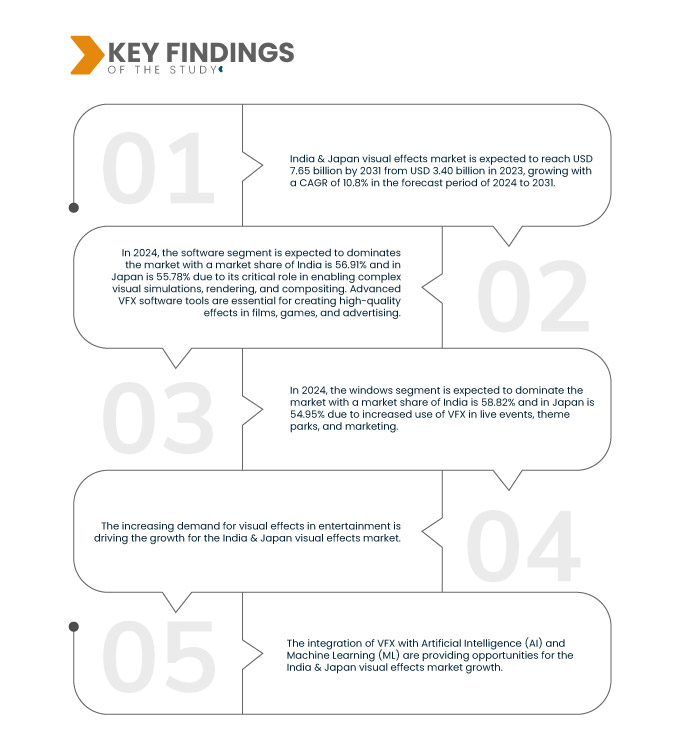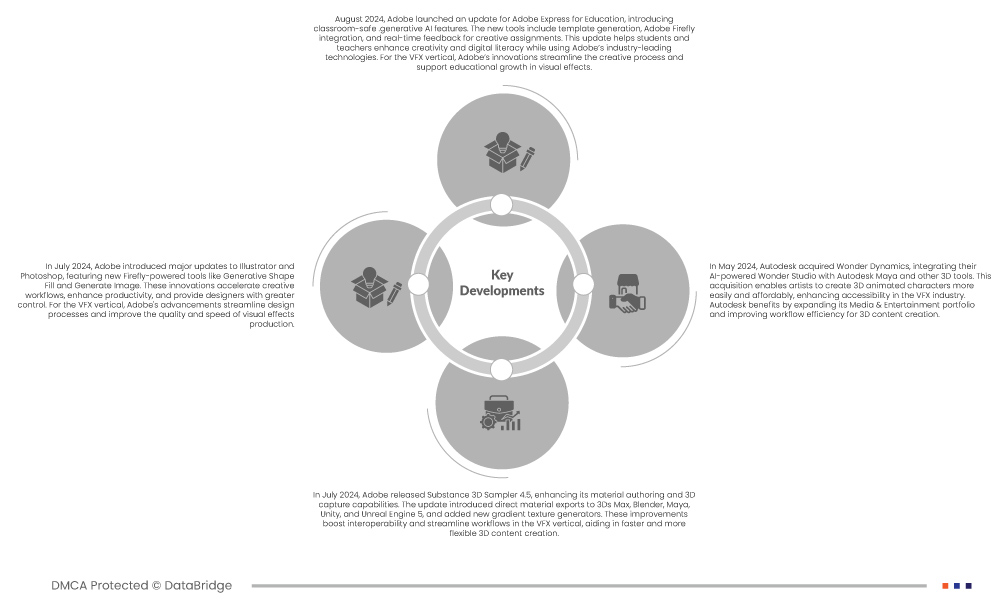The increasing demand for visual effects (VFX) in entertainment is driven by the need for more immersive and visually stunning experiences in films, TV shows, and high-quality videos. As audiences expect higher quality and more realistic effects, VFX technology continues to advance, enabling creators to push creative boundaries. This demand is fueled by the growing popularity of streaming platforms and the production of high-budget, content-rich projects, making VFX a critical component in storytelling and audience engagement across the entertainment industry.
Access Full Report @ https://www.databridgemarketresearch.com/jp/reports/india-and-japan-visual-effects-market
Data Bridge Market Research analyses that the India and Japan Visual Effects Market is expected to reach USD 7.65 billion by 2031 from USD 3.40 billion in 2023, growing with a CAGR of 10.8% in the forecast period of 2024 to 2031.
Key Findings of the Study
The Rise in OTT Platforms
The rise of OTT (Over-the-Top) platforms has dramatically transformed the entertainment landscape, driving an unprecedented demand for high-quality visual effects (VFX). As streaming services proliferate and audiences increasingly seek immersive and visually stunning content, the need for advanced VFX has surged. This shift is prompting content creators and studios to invest heavily in VFX to meet viewer expectations and stand out in a competitive market. The expansion of OTT platforms is not only enhancing the visibility of VFX but also pushing the boundaries of creativity and technological innovation in the industry.
Report Scope and Market Segmentation
|
Report Metric
|
Details
|
|
Forecast Period
|
2024 to 2031
|
|
Base Year
|
2023
|
|
Historic Years
|
2022 (Customizable from 2016-2021)
|
|
Quantitative Units
|
Revenue in USD Billion
|
|
Segments Covered
|
Offering (Software and Services), Operating System (Windows, MAC OS, Linux, and Others), Deployment Mode (On-Premises and Cloud), Organization Size (Large Organization Size and Small & Medium Organization Size), Effects (Digital Compositing, Matte Painting, Prosthetics Makeup, Stop Motion Animation, and Bullet Time), Application (Movies, Television, Gaming, Advertising, and Others)
|
|
Countries Covered
|
Japan and India
|
|
Market Players Covered
|
Adobe (U.S.), PIXAR (U.S.), Framestore (U.K), Industrial Light & magic (U.S.), Autodesk Inc. (U.S.), Company 3 (U.S.) and Blackmagic Design Pty. Ltd. (U.S.) among others
|
|
Data Points Covered in the Report
|
In addition to the market insights such as market value, growth rate, market segments, geographical coverage, market players, and market scenario, the market report curated by the Data Bridge Market Research team includes in-depth expert analysis, import/export analysis, pricing analysis, production consumption analysis, and PESTLE analysis.
|
Segment Analysis
India & Japan visual effects market is segmented into six notable segments which are based on offering, operating system, deployment mode, organization size, effects and application.
- On the basis of offering, the India & Japan visual effects market is segmented into software and services
In 2024, software segment is expected to dominates the India & Japan visual effects market
In 2024, the software segment is expected to dominates the market with a market share of India is 56.91% and in Japan is 55.78% due to its critical role in enabling complex visual simulations, rendering, and compositing. Advanced VFX software tools are essential for creating high-quality effects in films, games, and advertising.
- On the basis of operating system, the India & Japan visual effects market is segmented into windows, MAC OS, linux, and others
In 2024, windows segment is expected to dominates the India & Japan visual effects market
In 2024, the windows segment is expected to dominate the market with a market share of India is 58.82% and in Japan is 54.95% due to increased use of VFX in live events, theme parks, and marketing.
- On the basis of deployment mode, the India & Japan visual effects market is segmented into on-premises and cloud. In 2024, the on-premises segment is expected to dominate market with a market share of India is 65.69% and in Japan is 64.39%
- On the basis of organization size, the India & Japan visual effects market is segmented into large organization size and small & medium organization size. In 2024, the large organization size segment is expected to dominate the market with a market share of India is 65.28% and in Japan is 64.51%
- On the basis of effects, the Japan & India visual effects market is segmented into digital compositing, matte painting, prosthetics makeup, stop motion animation, bullet time. In 2024, the digital compositing segment is expected to dominate the market with a market share of India is 47.06% and in Japan is 41.77%
- On the basis of application, the India & Japan visual effects market is segmented into movies, television, gaming, advertising, and others. In 2024, the movies segment is expected to dominate the market with a market share of India is 58.87% and in Japan is 53.54%
Major Players
Data Bridge Market Research analyzes Adobe (U.S.), PIXAR (U.S.), and Framestore (U.K) as the major companies operating in the India & Japan visual effects market.
Market Developments
- In August 2024, Adobe launched an update for Adobe Express for Education, introducing classroom-safe generative AI features. The new tools include template generation, Adobe Firefly integration, and real-time feedback for creative assignments. This update helps students and teachers enhance creativity and digital literacy while using Adobe’s industry-leading technologies. For the VFX vertical, Adobe’s innovations streamline the creative process and support educational growth in visual effects
- In July 2024, Adobe introduced major updates to Illustrator and Photoshop, featuring new Firefly-powered tools like Generative Shape Fill and Generate Image. These innovations accelerate creative workflows, enhance productivity, and provide designers with greater control. For the VFX vertical, Adobe's advancements streamline design processes and improve the quality and speed of visual effects production
- In July 2024, Adobe released Substance 3D Sampler 4.5, enhancing its material authoring and 3D capture capabilities. The update introduced direct material exports to 3ds Max, Blender, Maya, Unity, and Unreal Engine 5, and added new gradient texture generators. These improvements boost interoperability and streamline workflows in the VFX vertical, aiding in faster and more flexible 3D content creation
- In May 2024, Autodesk acquired Wonder Dynamics, integrating their AI-powered Wonder Studio with Autodesk Maya and other 3D tools. This acquisition enables artists to create 3D animated characters more easily and affordably, enhancing accessibility in the VFX industry. Autodesk benefits by expanding its Media & Entertainment portfolio and improving workflow efficiency for 3D content creation
Regional Analysis
Geographically, the countries covered in the market report are India and Japan.
As per Data Bridge Market Research analysis:
Japan is expected to dominate the India & Japan visual effects market
Japan dominates the visual effects market due to its strong tradition in animation and manga, which fosters a culture of high-quality, innovative visual storytelling.
India is expected to be the fastest growing country in the India & Japan visual effects market
India is expected to be the fastest growing country due to benefits from a robust pipeline of skilled artists and cutting-edge technology, enabling it to produce visually stunning and unique effects.
For more detailed information about India & Japan visual effects market report, click here – https://www.databridgemarketresearch.com/jp/reports/india-and-japan-visual-effects-market














